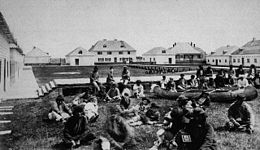Norway House, Manitoba
| Norway House | |
|---|---|

Inside the fort at Norway House, NWT 1878
|
|
| Coordinates: 53°59′25″N 97°48′56″W / 53.99028°N 97.81556°WCoordinates: 53°59′25″N 97°48′56″W / 53.99028°N 97.81556°W | |
| Country | Canada |
| Province | Manitoba |
| Census division | 22 |
| Region | Northern Region |
| Time zone | CST (UTC−5) |
| • Summer (DST) | CDT (UTC−6) |
| Website |
Norway House Cree Nation Norway House |
| Official name | Norway House National Historic Site of Canada |
| Designated | 1932 |
Norway House is a population centre of over 5,000 people some 30 km (19 mi) north of Lake Winnipeg, on the bank of the eastern channel of Nelson River, in the province of Manitoba, Canada. The population centre shares the name Norway House with the northern community of Norway House and Norway House 17, a First Nation reserve of the Norway House Cree Nation (Kinosao Sipi Cree Nation). Thus Norway House has both a Chief and a Mayor.
The community is located 456 km (283 mi) by air north of Winnipeg, 208 km (129 mi) by air east of The Pas, and 190 km (120 mi) by air south of Thompson. To drive from Winnipeg it is approximately 800 km (500 mi), from Thompson it is about 300 km (190 mi). Major economic activities include commercial fishing, trapping, logging, and government services. Seasonal unemployment varies, with peaks as high as 70%.
Norway House was an important establishment of the Hudson's Bay Company for most of the 19th century, serving as a major depot and from the 1830s as the seat of the Council of the Northern Department of Rupert's Land.
After the arrival of Europeans in North America, the Hayes River became an important link in the development of Canada. The Hayes was the favoured route between York Factory and the interior of western Canada for explorers, fur traders and European settlers from 1670 to 1870 because transit was easier and food was more readily available. After Anthony Henday's explorations, Joseph Smith was sent in 1756, from York Factory, to explore the area. He ascended the Nelson River seeking Lake Winnipeg. He reached Little Playgreen Lake on September 21 that year.
In 1816 Lord Selkirk sent out a band of Norwegians, apparently ex-convicts, to build a road from York Factory to Lake Winnipeg and a series of supply posts. They built Norway House at Mossy Point (west side of outflow) in 1817 replacing the former Jack River post at that location. In the last days of the rivalry between the Hudson's Bay Company and the North West Company prior to their union in 1821, Colin Robertson, of the Hudson's Bay Company from their office in Montreal, organized a brigade of mostly French-Canadians led by John Clarke, bound for the Athabasca country to compete with the North West Company by developing the trade of supplying the colonists in addition to the company's usual business of trading furs.
...
Wikipedia

